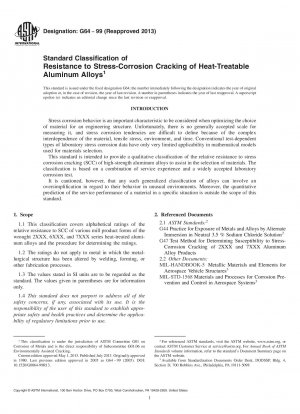ASTM G64-99(2013)
Standard Classification of Resistance to Stress-Corrosion Cracking of Heat-Treatable Aluminum Alloys
- Standard No.
- ASTM G64-99(2013)
- Release Date
- 1999
- Published By
- American Society for Testing and Materials (ASTM)
- Status
- Replace By
- ASTM G64-99(2021)
- Latest
- ASTM G64-99(2021)
- Scope
4.1 This classification involves alphabetical ratings intended only to provide a qualitative guide for materials selection. The ratings are based primarily on the results of standard corrosion tests.
4.2 Interpretations of the SCC ratings in terms of typical problem areas including service experience are given in Table 1. Practical experience has shown that SCC problems with aluminum alloys generally have involved situations where the direction and magnitude of the tensile stresses resulting from manufacturing or use, or both, of the material were not recognized.
Note 1—The stress levels mentioned below and the test stresses mentioned in 6.2 are not to be interpreted as “threshold” stresses, and are not recommended for design. Other documents, such as MIL-HANDBOOK-5, MIL-STD-1568, NASC SD-24, and MSFC-SPEC-522A, should be consulted for design recommendations.4.3 A list of the SCC ratings for the heat-treatable aluminum alloy products is given in Table 2. Revisions to the table will be required as new materials become available and additional test results are accumulated.
4.4 These alphabetical ratings are not suitable for direct use in mathematical models for material selection, but numerical weights and confidence factors can be devised on the basis of experience and judgment of the materials engineer.5
1.1 This classification covers alphabetical ratings of the relative resistance to SCC of various mill product forms of the wrought 2XXX, 6XXX, and 7XXX series heat-treated aluminum alloys and the procedure for determining the ratings.
1.2 The ratings do not apply to metal in which the metallurgical structure has been altered by welding, forming, or other fabrication processes.
ASTM G64-99(2013) Referenced Document
- ASTM G44 Standard Practice for Exposure of Metals and Alloys by Alternate Immersion in Neutral 3.5?% Sodium Chloride Solution
- ASTM G47 Standard Test Method for Determining Susceptibility to Stress-Corrosion Cracking of 2XXX and 7XXX Aluminum Alloy Products*, 2019-06-15 Update
ASTM G64-99(2013) history
- 2021 ASTM G64-99(2021) Standard Classification of Resistance to Stress-Corrosion Cracking of Heat-Treatable Aluminum Alloys
- 1999 ASTM G64-99(2013) Standard Classification of Resistance to Stress-Corrosion Cracking of Heat-Treatable Aluminum Alloys
- 1999 ASTM G64-99(2005) Standard Classification of Resistance to Stress-Corrosion Cracking of Heat-Treatable Aluminum Alloys
- 1999 ASTM G64-99 Standard Classification of Resistance to Stress-Corrosion Cracking of Heat-Treatable Aluminum Alloys
